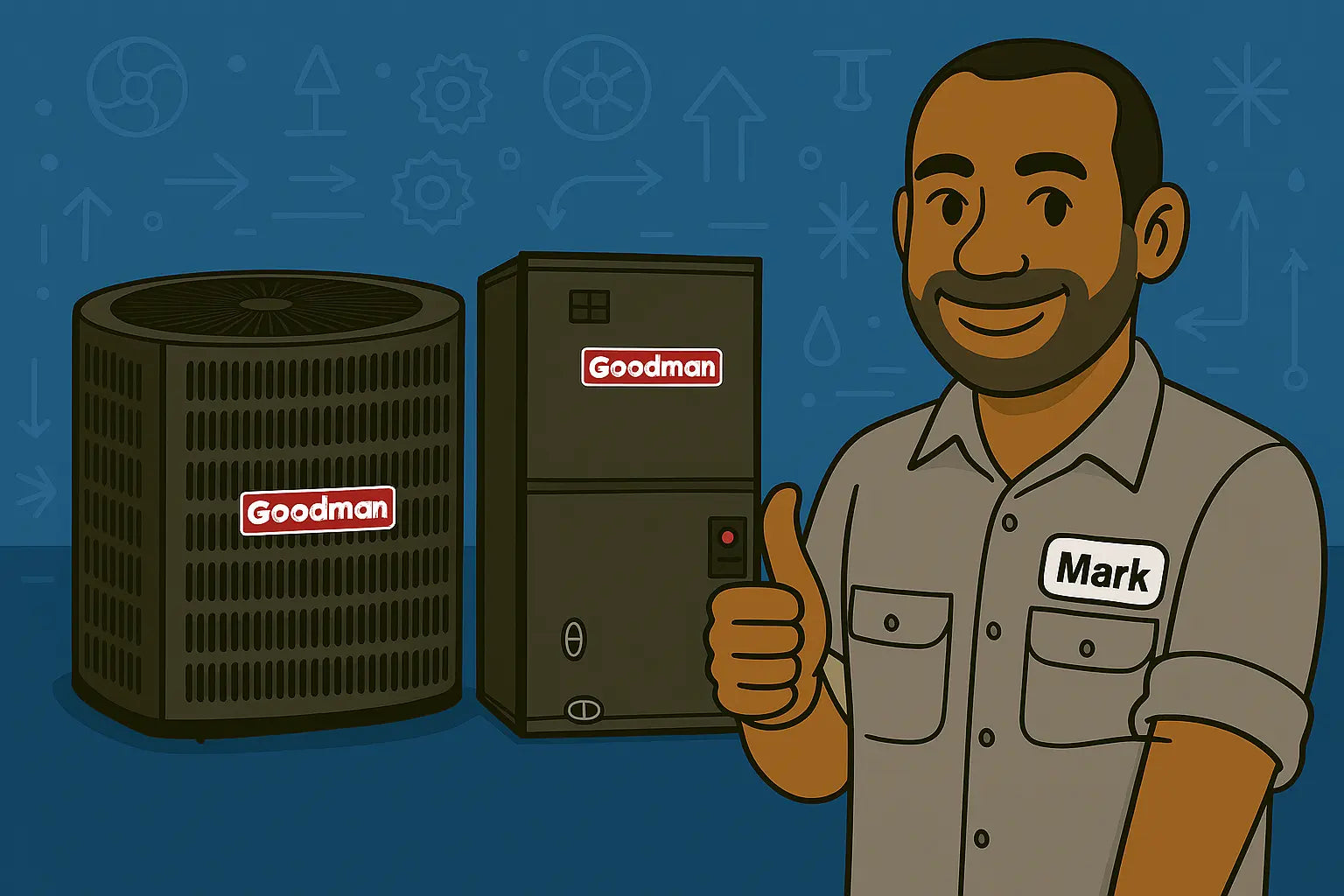Introduction: Mark’s First Word
Hey folks, Mark here 👋. If you’ve ever rolled up your sleeves to work on a Goodman 5-ton system, you know it’s not just about plugging stuff in and flipping a switch. This beast—the GLXS4BA6010 condenser paired with the AMST60DU1300 air handler—packs a lot of punch, but only if it’s installed right and cared for along the way. And trust me, if something goes sideways, you’ll want to know how to troubleshoot before you call in backup.
In this guide, I’m walking you through installation basics, common problems, fixes that work, and some straight-shooting advice I’ve picked up over the years. Ready? Let’s get this system humming like new.
Understanding the Goodman GLXS4BA6010 & AMST60DU1300
This system is built for bigger cooling loads—5 tons of power at a 14.3 SEER2 efficiency rating. The GLXS4BA6010 condenser uses R-32 refrigerant, which is more environmentally friendly than the old R-410A. The AMST60DU1300 air handler uses a multi-speed ECM blower that can adjust airflow depending on demand, saving energy while keeping your home comfortable.
To put it in perspective, that much cooling power can handle homes in the 2,500–3,200 sq. ft. range, depending on your insulation and climate. If you’re looking at this system, chances are you’ve got some serious cooling needs.
Installation Tips: Doing It Right the First Time
I’ve seen too many installs where shortcuts come back to haunt the homeowner. Here’s my step-by-step breakdown:
-
Pick the Right Spot for the Condenser
Place it outside where it gets good airflow, at least 2 feet from walls or fences. Don’t stick it in a corner with no breathing room—that’s just begging for overheating. -
Level the Unit
Condensers that aren’t level can cause compressor wear. Use a concrete pad or a sturdy plastic base. A half-hour spent leveling saves you a world of trouble later. -
Electrical Work
Always follow Goodman’s wiring diagram in the manual. One wrong connection, and you’re looking at tripped breakers or worse. If you’re not confident with electrical, bring in a pro. -
Refrigerant Lines
Match line size to the manual, insulate them properly, and keep the runs as short and straight as possible. Long, sloppy refrigerant runs hurt efficiency. -
Air Handler Setup
The AMST60DU1300 can be set up in different orientations (upflow, downflow, horizontal). Choose what fits your ductwork best, but make sure there’s easy access for future maintenance.
For deeper technical details, Goodman provides installation resources you should absolutely reference.
Troubleshooting: When Things Go Wrong
Even with a perfect install, stuff happens. Here’s how I usually tackle the big ones:
-
System not cooling
Start with the thermostat—simple, but often overlooked. Then check breakers, disconnects, and the contactor at the condenser. If all that’s good, low refrigerant or a faulty capacitor might be the culprit. -
Weak airflow
Nine times out of ten, it’s a clogged filter or a blower motor issue. The ECM motors are reliable, but if the airflow feels like a whisper, check for duct leaks or restrictions too. -
Ice on the coils
That usually means low refrigerant charge or poor airflow. Shut the system down before you damage the compressor. Let it thaw and check refrigerant pressures with gauges. -
Strange noises
Rattles mean something’s loose. Grinding? That’s usually a blower or fan motor bearing going bad. Buzzing at startup could be a failing contactor or capacitor.
For a more technical troubleshooting checklist, Energy.gov’s HVAC guide is a solid reference.
Maintenance: Keeping Things Running Smooth
You’ve installed it, you’ve fixed it once or twice—now let’s keep it running. Regular maintenance is the cheapest way to avoid costly repairs.
-
Replace filters every 1–3 months.
-
Clean condenser coils yearly. A dirty coil can drop your efficiency fast.
-
Check refrigerant charge annually. A system running low works harder, costs more, and shortens compressor life.
-
Flush the condensate drain line. A clogged drain can cause water damage indoors.
-
Inspect electrical connections and tighten if needed. Vibrations loosen them over time.
For a homeowner’s level guide, Energy Star’s maintenance tips are easy to follow and practical.
Safety First
Working with R-32 means you’ve got an A2L refrigerant on your hands. It’s mildly flammable, so you need proper tools, ventilation, and safety gear. Always follow EPA guidelines when handling refrigerants.
Mark’s Final Thoughts
Alright, folks, here’s the straight talk 🍻. The Goodman GLXS4BA6010 condenser paired with the AMST60DU1300 air handler is a reliable, high-performance system when installed and maintained properly. Follow the installation tips, tackle maintenance regularly, and handle small troubleshooting issues as they come, and this 5-ton 14 SEER2 R-32 system will keep your home comfortably cool for years.
Remember, safety first—electricity and refrigerants aren’t things to mess with. Know your limits, use the right tools, and when in doubt, call a licensed pro.
If you’re ready to check out the system or grab the specs straight from the source, here’s the official product link: Goodman 5-Ton 14 SEER2 R-32 System. Following the guidance here will make sure you get the most out of your investment, keep it running efficiently, and avoid unnecessary headaches.
Want to know how to install the AC in this combo? Visit my guide: A Tech’s Hands-On Walkthrough.
Keep your cool, take it step by step, and enjoy the satisfaction of a job done right. Trust me, nothing beats the hum of a properly installed and perfectly functioning HVAC system.
- Mark, your go-to HVAC tech!







